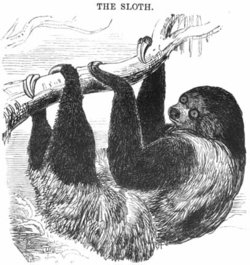Sloth
|
|
| Sloths | ||||||||
|---|---|---|---|---|---|---|---|---|
 A sloth, as depicted in the 1851 Illustrated London Reading Book | ||||||||
| Scientific classification | ||||||||
| ||||||||
| Families | ||||||||
|
Megalonychidae |
Sloths are medium-sized South American mammals belonging to the families Megalonychidae and Bradypodidae, part of the order Xenarthra. Sloths are herbivores, eating very little other than leaves.
Sloths have made extraordinary adaptations to an arboreal browsing lifestyle. Leaves, their main food source, provide very little energy or nutrition and do not digest easily: sloths have very large, specialised, slow-acting stomachs with multiple compartments in which symbiotic bacteria break down the tough leaves. Sloths may also eat insects and small lizards and carrion. As much as two thirds of a well-fed sloth's body-weight consists of the contents of its stomach, and the digestive process can take as long as a month or more to complete. Even so, leaves provide little energy, and sloths deal with this by a range of economy measures: they have very low metabolic rates (less than half of that expected for a creature of their size), and maintain low body temperatures when active (30 to 34 degrees Celsius), and still lower temperatures when resting.
Sloths move only when necessary and then very slowly: they have about half as much muscle tissue as other animals of similar weight. They can move at a higher speed, which still isn't all that fast, if they are in immediate danger from a predator, but they burn large amounts of energy doing so. Their specialised hands and feet have long, curved claws to allow them to hang upside-down from branches without effort. While they sometimes sit on top of branches, they usually eat, sleep and even give birth hanging from limbs. They are particularly partial to nesting in the crowns of palm trees where they can camouflage as a coconut. They come to the ground, to urinate and defecate, only about once a week.
Sloth fur too exhibits specialised functions: the outer hairs grow in the opposite direction to that of other mammals, i.e. pointing away from their extremities (so as to provide protection from the elements despite living legs-uppermost), and in moist conditions host two species of symbiotic blue-green algae, which provide camouflage and possibly extra nutrition, either licked directly from the fur or absorbed through the skin. Many wild sloths will actually look like they have green fur because of the algae.
Their claws also serve as their only natural defence. A cornered sloth may swipe at its attackers in a usually futile effort to scare them away. Despite sloths' apparent defencelessness, predators do not pose special problems: in the trees sloths have good camouflage and, moving only slowly, do not attract attention. Only during their infrequent visits to ground level do they become vulnerable. The main predators of sloths are the jaguar, the harpy eagle, and humans. The majority of sloth deaths in Costa Rica are from sloths getting into electrical lines and from poachers. Despite their adaptation to living in trees, sloths make competent swimmers.
Infant sloths normally cling to their mother's fur, but occasionally fall off. Sloths are very sturdily built and very few die from the fall. In some cases they die from the fall indirectly because the mothers sometimes prove unwilling to leave the safety of the trees to retrieve them.
Until geologically recent times, large ground-dwelling sloths of the Megatherium type lived in North America, but along with many other species they became extinct immediately after the arrival of humans on the continent. Much evidence suggests that the extinction of the American megafauna, like that of Australia, far northern Asia, and New Zealand, resulted from human activity. Nevertheless, debate on the matter continues.
The living sloths belong to one of two families, known as the two-toed and three-toed sloths. Both families have three toes: the "two-toed" sloths, however, have only two fingers. Two-toed sloths are generally faster moving than three-toed sloths. Both types tend to occupy the same forests: in most areas, a particular single species of three-toed sloth and a single species of the larger two-toed type will jointly predominate.
Although unable to survive outside the tropical rainforests of South and Central America, within that environment sloths are outstandingly successful creatures: they can account for as much as half the total energy consumption and two-thirds of the total terrestrial mammalian biomass in some areas. Of the five species, only one, the Maned Three-toed Sloth, has a classification of "endangered" at present. The ongoing destruction of South America's forests, however, may soon prove a threat to the others.

